|
Link:http://output.to/sideway/default.asp?qno=160900017 Euclid's Elements Book 3
The Euclid's Elements of Geometry
Geometry is the study of figures. Euclid's Elements provides the
most fundamental way of learning geometry geometrically. based on
Book III: Theory of circles
.
Definitions
.
-
Equal circles are those whose diameters are equal, or whose radii are
equal.
-
A straight line is said to touch a circle which, meeting the circle and being
produced, does not cut the circle.
-
Circles are said to touch one another which meet one another but do not cut one
another.
-
Straight lines in a circle are said to be equally distant from the center when
the perpendiculars drawn to them from the center are equal.
-
And that straight line is said to be at a greater distance on which the greater
perpendicular falls.
-
A segment of a circle is the figure contained by a straight line and a
circumference of a circle.
-
An angle of a segment is that contained by a straight line and a circumference
of a circle.
-
An angle in a segment is the angle which, when a point is taken on the
circumference of the segment and straight lines are joined from it to the ends
of the straight line which is the base of the segment, is contained by the
straight lines so joined.
-
And, when the straight lines containing the angle cut off a circumference, the
angle is said to stand upon that circumference.
-
A sector of a circle is the figure which, when an angle is constructed at the
center of the circle, is contained by the straight lines containing the angle
and the circumference cut off by them.
-
Similar segments of circles are those which admit equal angles, or in which the
angles equal one another.
Propositions
-
To find
the center of a given circle.
Corollary: If in a circle a straight line cuts a straight line into two equal
parts and at right angles, then the center of the circle lies on the cutting
straight line.
-
If two points are taken at random on the circumference of a circle, then the
straight line joining the points falls within the circle.
-
If a straight line passing through the center of a circle bisects a straight
line not passing through the center, then it also cuts it at right angles; and
if it cuts it at right angles, then it also bisects it.
-
If in a circle two straight lines which do not pass through the center cut one
another, then they do not bisect one another.
-
If two circles cut one another, then they do not have the same center.
-
If two circles touch one another, then they do not have the same center.
-
If on the diameter of a circle a point is taken which is not the center of the
circle, and from the point straight lines fall upon the circle, then that is
greatest on which passes through the center, the remainder of the same diameter
is least, and of the rest the nearer to the straight line through the center is
always greater than the more remote; and only two equal straight lines fall from
the point on the circle, one on each side of the least straight line.
-
If a point is taken outside a circle and from the point straight lines are drawn
through to the circle, one of which is through the center and the others are
drawn at random, then, of the straight lines which fall on the concave
circumference, that through the center is greatest, while of the rest the nearer
to that through the center is always greater than the more remote, but, of the
straight lines falling on the convex circumference, that between the point and
the diameter is least, while of the rest the nearer to the least is always less
than the more remote; and only two equal straight lines fall on the circle from
the point, one on each side of the least.
-
If a point is taken within a circle, and more than two equal straight lines fall
from the point on the circle, then the point taken is the center of the circle.
-
A circle does not cut a circle at more than two points.
-
If two circles touch one another internally, and their centers are taken, then
the straight line joining their centers, being produced, falls on the point of
contact of the circles.
-
If two circles touch one another externally, then the straight line joining
their centers passes through the point of contact.
-
A circle does not touch another circle at more than one point whether it touches
it internally or externally.
-
Equal straight lines in a circle are equally distant from the center, and those
which are equally distant from the center equal one another.
-
Of straight lines in a circle the diameter is greatest, and of the rest the
nearer to the center is always greater than the more remote.
-
The straight line drawn at right angles to the diameter of a circle from its end
will fall outside the circle, and into the space between the straight line and
the circumference another straight line cannot be interposed, further the angle
of the semicircle is greater, and the remaining angle less, than any acute
rectilinear angle.
Corollary: From this it is manifest that the straight line drawn at right angles
to the diameter of a circle from its end touches the circle.
-
From a given point to draw a straight line touching a given circle.
-
If a straight line touches a circle, and a straight line is joined from the
center to the point of contact, the straight line so joined will be
perpendicular to the tangent.
-
If a straight line touches a circle, and from the point of contact a straight
line is drawn at right angles to the tangent, the center of the circle will be
on the straight line so drawn.
-
In a circle the angle at the center is double the angle at the circumference
when the angles have the same circumference as base.
-
In a circle the angles in the same segment equal one another.
-
The sum of the opposite angles of quadrilaterals in circles equals two right
angles.
-
On the same straight line there cannot be constructed two similar and unequal
segments of circles on the same side.
-
Similar segments of circles on equal straight lines equal one another.
-
Given a segment of a circle, to describe the complete circle of which it is a
segment.
-
In equal circles equal angles stand on equal circumferences whether they stand
at the centers or at the circumferences.
-
In equal circles angles standing on equal circumferences equal one another
whether they stand at the centers or at the circumferences.
-
In equal circles equal straight lines cut off equal circumferences, the greater
circumference equals the greater and the less equals the less.
-
In equal circles straight lines that cut off equal circumferences are equal.
-
To bisect a given circumference.
-
In a circle the angle in the semicircle is right, that in a greater segment less
than a right angle, and that in a less segment greater than a right angle;
further the angle of the greater segment is greater than a right angle, and the
angle of the less segment is less than a right angle.
-
If a straight line touches a circle, and from the point of contact there is
drawn across, in the circle, a straight line cutting the circle, then the angles
which it makes with the tangent equal the angles in the alternate segments of
the circle.
-
On a given straight line to describe a segment of a circle admitting an angle
equal to a given rectilinear angle.
-
From a given circle to cut off a segment admitting an angle equal to a given
rectilinear angle.
-
If in a circle two straight lines cut one another, then the rectangle contained
by the segments of the one equals the rectangle contained by the segments of the
other.
-
If a point is taken outside a circle and two straight lines fall from it on the
circle, and if one of them cuts the circle and the other touches it, then the
rectangle contained by the whole of the straight line which cuts the circle and
the straight line intercepted on it outside between the point and the convex
circumference equals the square on the tangent.
-
If a point is taken outside a circle and from the point there fall on the circle
two straight lines, if one of them cuts the circle, and the other falls on it,
and if further the rectangle contained by the whole of the straight line which
cuts the circle and the straight line intercepted on it outside between the
point and the convex circumference equals the square on the straight line which
falls on the circle, then the straight line which falls on it touches the
circle.
Link:http://output.to/sideway/default.asp?qno=160900018 Windows 8.1 Knowledge Base Setting Automatic Update
Microsoft Windows 8.1 Setting Windows Automatic Update
Configuration of Automatic Updates in Windows 8.1
Windows automatic update provides a way to help keeping Windows up to date with
the latest patches, service packs, and other updates. Depending on the automatic
update setting, the Windows automatice update can be a little more automatic or
a little more manual.
Steps To Configure Windows Automatic Updates
- To open Windows Update window for setting
- Activate the right edge charms bar by swiping in from the right edge of the screen, or by
moving the mouse pointer to the lower-right corner or upper-right corner of the screen and
then moving the mouse pointer up or down accordingly.

- Move mouse to highlight the charms bar.
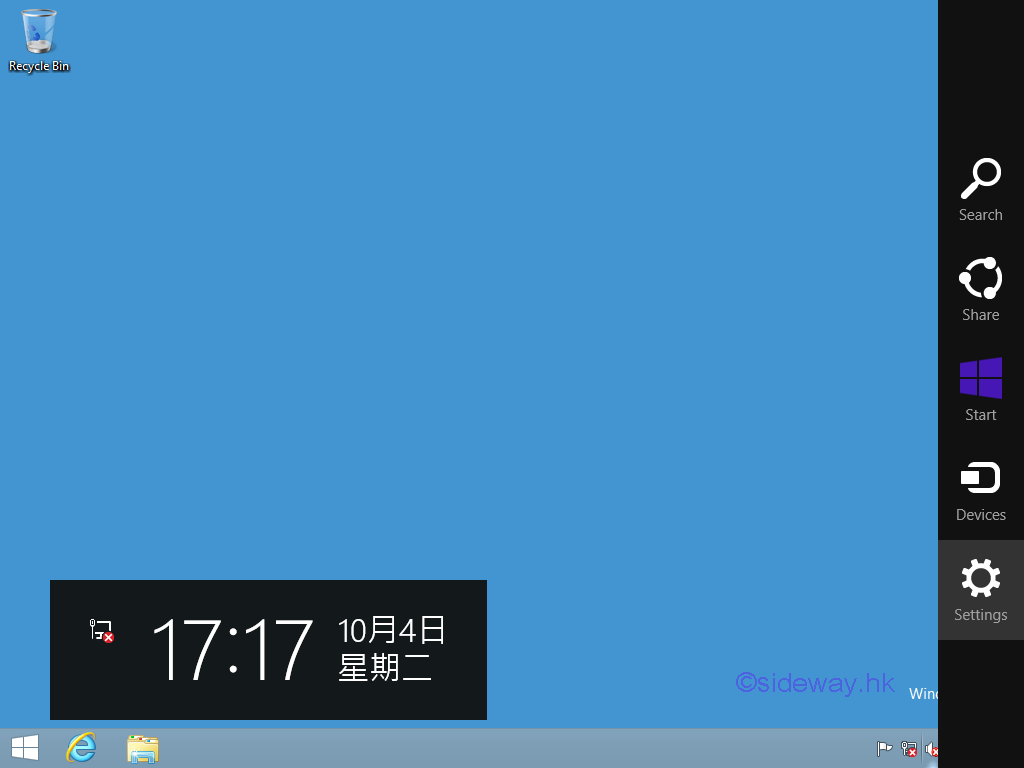
- then tapping or clicking "Settings" to open the setting charm,
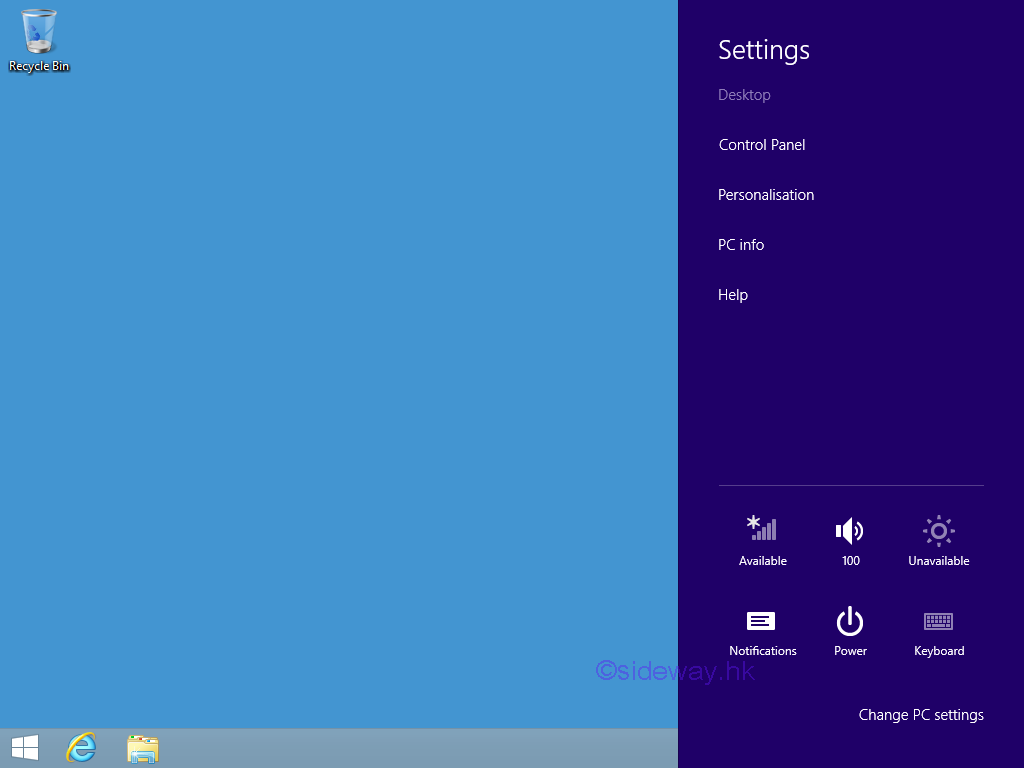
- tapping or clicking "Control Panel" to open the control panel window,
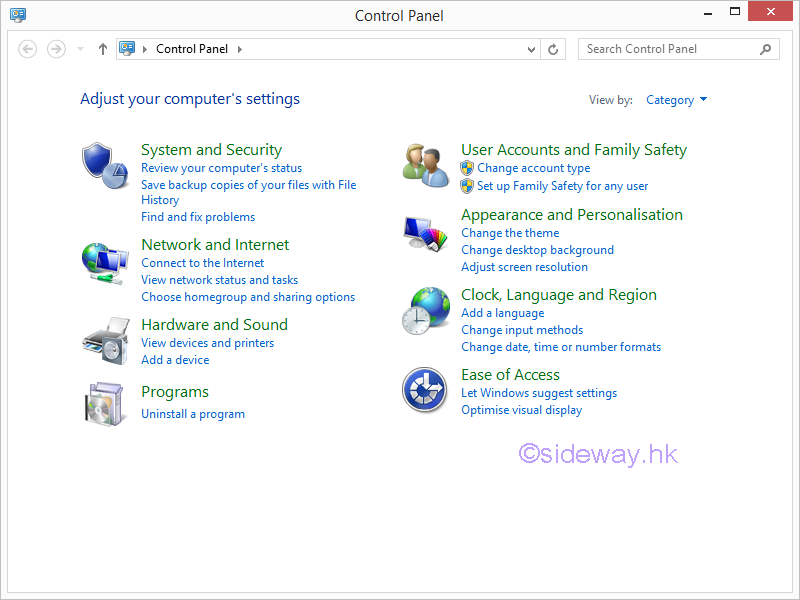
- and then tapping or clicking "System and Security" to open system and security window,
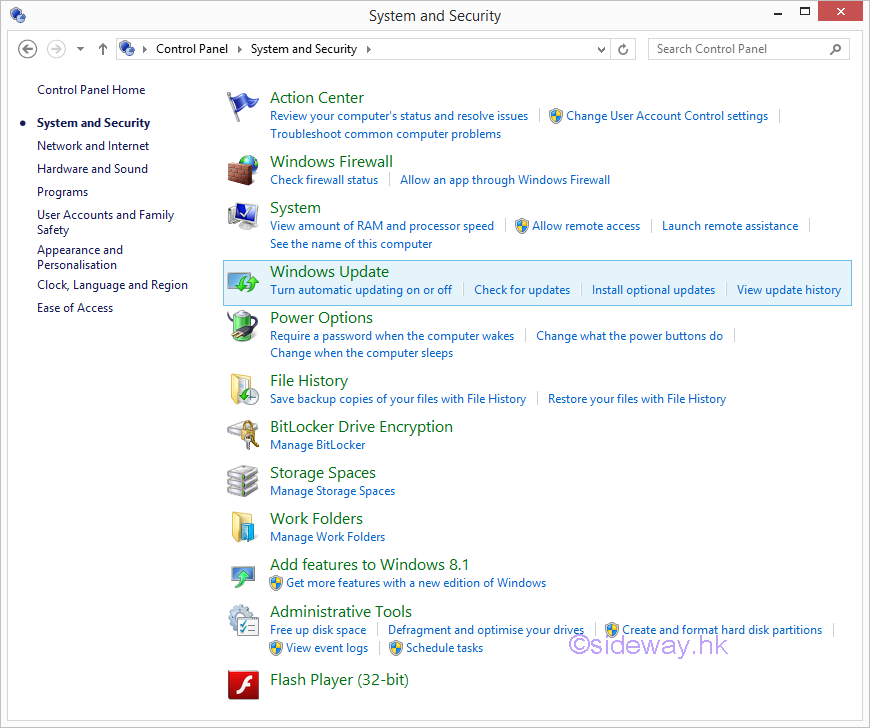
- then tapping or clicking Windows Update to open the windows update window.
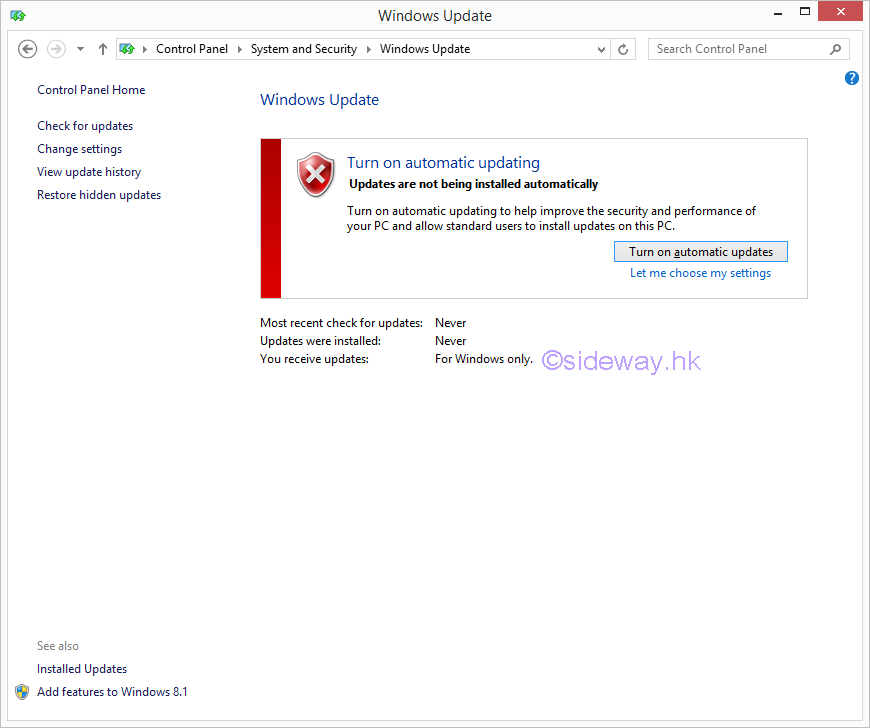
- Tap or click "Let me choose my settings" or "Change settings" to choose how updates get installed. Some possible options are
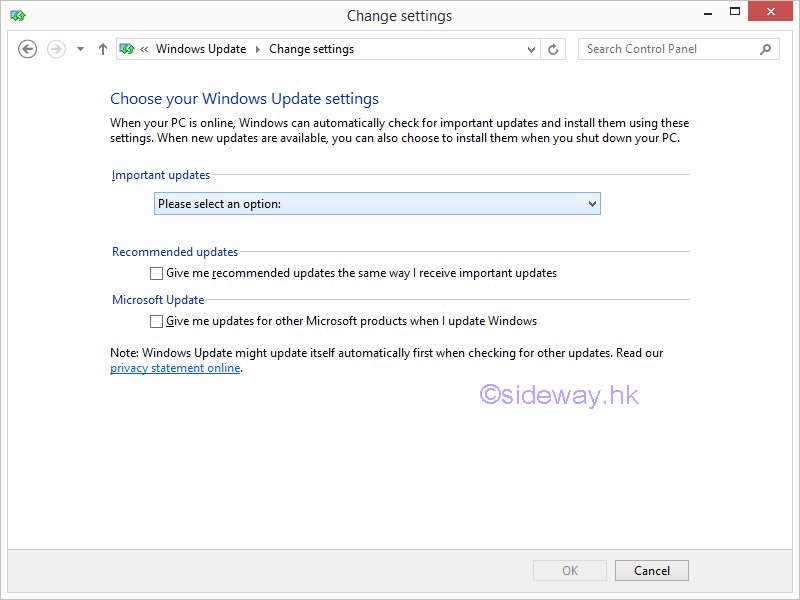
- For Important updates, click "Please select an option" to select an option.
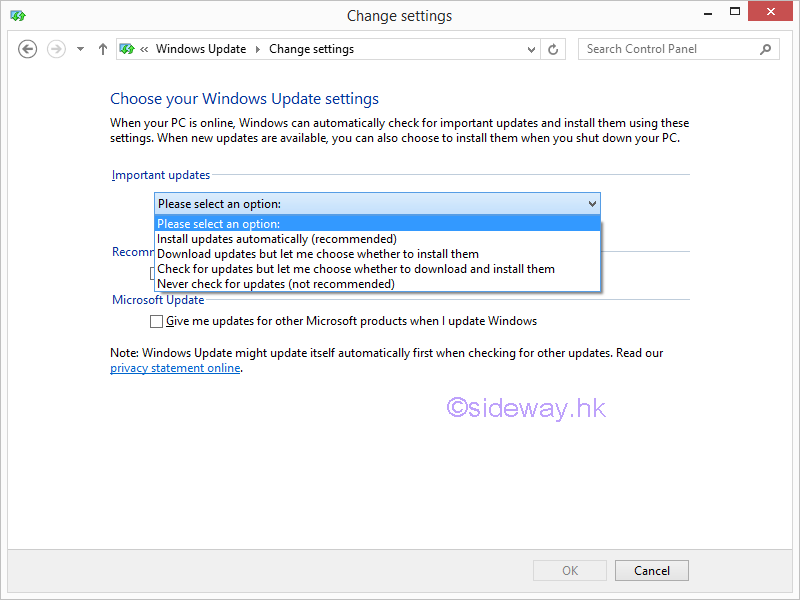
- Install updates automatically (recommended): Choose this option to have Windows
Update automatically check for, download, and install important security
patches.
- Download updates but let me choose whether to install them: Choose this to have
Windows Update automatically check for and download important updates but not
install them. You'll have to explicitly choose to install the updates either
from Windows Update or during the next shutdown process.
- Check for updates but let me choose whether to download and install them: With
this option, Windows Update will check for and notify you of available updates
but you'll need to manually approve the download and installation of them.
- Never check for updates (not recommended): This option disables Windows Update
completely in Windows 8, 7, or Vista. When you choose this, Windows Update won't
even check with Microsoft to see if important security patches are even
available. Here are what some of those other checkboxes mean, not all of which
you'll see, depending on your version of Windows and how your computer is
configured:
- For Recommended updates
- Give me recommended updates the same way I receive important updates: This
option gives Windows Update permission to treat patches that Microsoft
"recommends" the same way as patches thought to be "critical" or "important" and
download and install them as you've selected in the drop-down box.
- Allow all users to install updates on this computer: Check this if you have
other, non-administrator accounts on your computer that actually get used. This
will let those users install updates too.
- For Microsoft Update
- Give me updates for other Microsoft products when I update Windows: Check this
option, which is a bit more wordy in Windows 7 & Vista, if you own other
Microsoft software and you want Windows Update to handle updating those as well.
- Show me detailed notifications when new Microsoft software is available: This is
pretty self explanatory - check it if you want to get notifications, via Windows
Update, when Microsoft software you don't have installed is available for your
computer.
- click OK to continue.
|
|
 Sideway
BICK BLOG from Sideway
Sideway
BICK BLOG from Sideway








